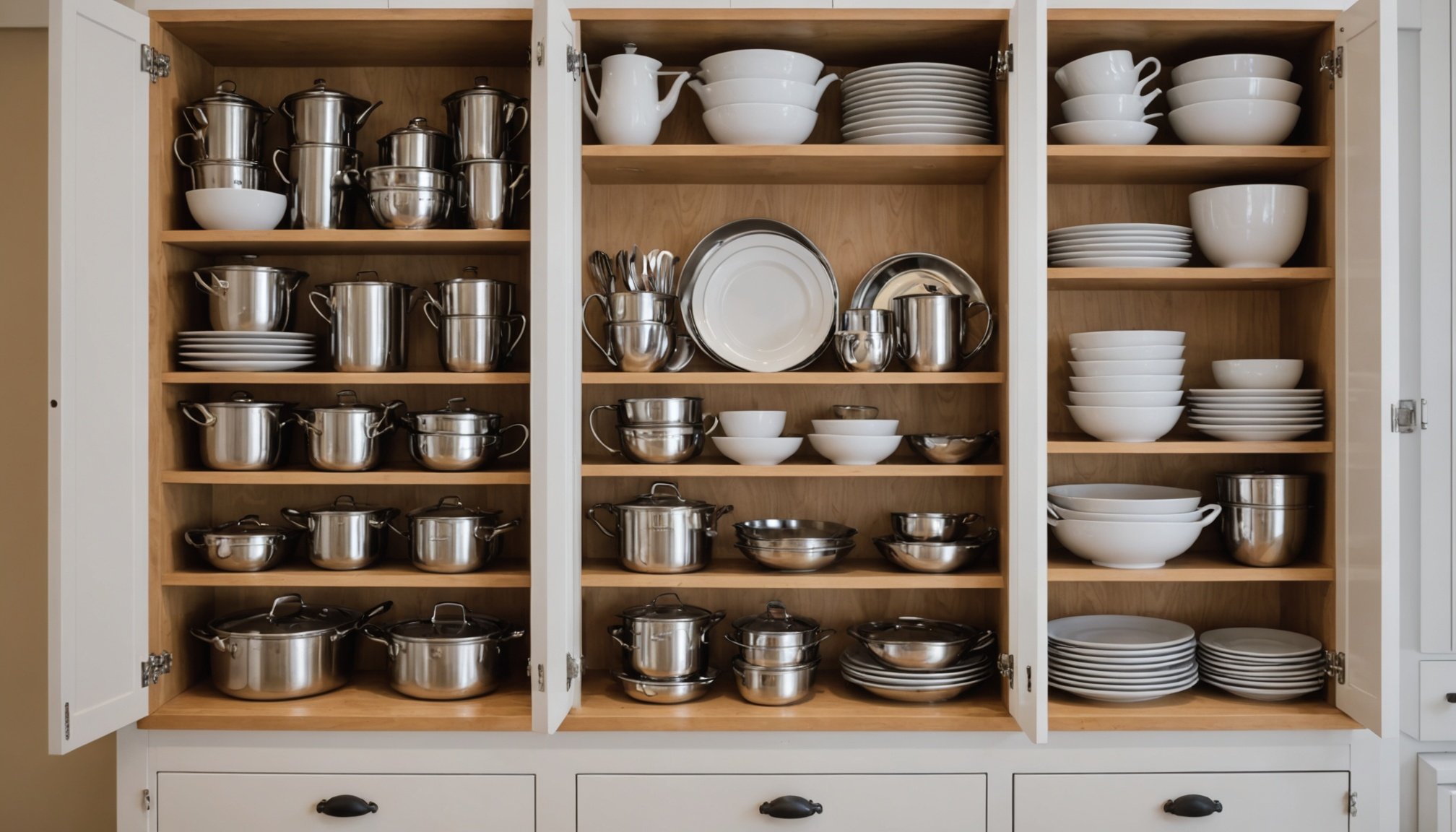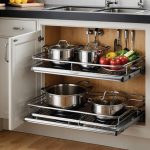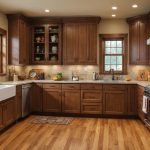Understanding Cabinet-Free Kitchen Concepts
The cabinet-free kitchen trend, rooted in minimalist design, emphasises simplicity and openness. Emerging from a desire for clutter-free spaces, this approach trades traditional cabinets for open shelving. Open shelving offers a lighter, airier feel, transforming the kitchen into an accessible and personable space.
One key benefit is maximising space; without cabinets, kitchens can appear much larger and more inviting. Open shelving not only encourages organisation but also allows easy access to everyday items. Displaying cookware, crockery, and other items becomes an opportunity to add character and charm.
In the same genre : The definitive handbook to choosing ideal kitchen cabinet organizers for your uk home
Furthermore, a minimalist design can dramatically enhance both the functionality and aesthetics of a kitchen. By focusing on essentials and reducing unnecessary clutter, homeowners can enjoy a more streamlined experience. The removal of bulky cabinets facilitates fluidity in design and usage, encouraging a purer form of functionality.
In essence, adopting a cabinet-free approach not only revamps the kitchen environment but also redefines how space and aesthetics coexist, aligning with modern-day principles of simplicity and elegance.
Have you seen this : Designing a stylish and pet-friendly kitchen in the uk: essential tips for a chic and functional space
Innovative Storage Solutions for Cabinet-Free Kitchens
Exploring creative storage is crucial for a cabinet-free kitchen. Vertical space can be maximised through shelves, hooks, and pegboards, transforming unused wall areas into practical storage zones. These solutions offer accessible and efficient means to store essentials while maintaining an airy, open feel.
Multifunctional furniture offers another innovative avenue. Consider pieces like a kitchen island with built-in storage compartments or a dining table that doubles as additional counter space. These items not only save space but also enhance the utility by integrating various functions.
Additionally, under-counter and overhead storage solutions can provide smart alternatives for keeping a kitchen organised. Installing pull-out drawers or overhead racks ensures that every inch of space is used efficiently, keeping countertops free for use. These thoughtful integrations demonstrate how creativity in storage solutions can complement the simplicity and functionality of minimalist kitchen designs.
By leveraging these strategies, a cabinet-free kitchen can remain both organised and visually appealing, fostering a seamless balance between functionality and aesthetics. This approach promotes a clean appearance while supporting the practical needs of everyday kitchen tasks.
UK-Specific Design Styles for Cabinet-Free Kitchens
Adopting a cabinet-free kitchen doesn’t mean sacrificing style or functionality, especially within UK homes. Various UK kitchen design styles beautifully complement this minimalist approach, offering both contemporary flair and rustic appeal. Integrating elements from traditional and contemporary styles can redefine the kitchen space, showcasing an inviting yet modern atmosphere.
For instance, sleek lines and neutral palettes often characterise contemporary designs, which pair effortlessly with the open aesthetics of this trend. Meanwhile, UK homes with a rustic appeal can incorporate natural textures and vintage elements to maintain warmth and character within the minimalist setup.
Examining real-life case studies across the UK reveals creative mixes of modern and traditional techniques. These kitchens have successfully transitioned to the cabinet-free trend, underscoring the versatile appeal of minimalist design. They exhibit how small adjustments—such as using earthy tones or industrial materials—can enhance both style and functionality. Lessons drawn from these transformations highlight the meticulous balance of aesthetics and practicality, providing insight into the effective implementation of cabinet-free kitchens while retaining quintessential UK charm.
Essential Tools and Accessories for a Functional Kitchen
To optimise a cabinet-free kitchen, selecting the right kitchen tools and organization tools is crucial. These elements ensure that the space remains both functional and aesthetically pleasing. Here are some essential tools to consider:
-
Storage accessories such as baskets and containers play an important role in efficient organization. They help in neatly categorising items, easing access, and preserving a tidy look.
-
Prioritise versatile kitchen tools that save space. Opt for multi-use items like a combination blender and food processor, or stackable cookware that minimises clutter without compromising on utility.
For an effective approach, understand your unique kitchen demands. This means selecting tools that cater specifically to your culinary habits. Properly arranged tools can enhance workflow, enabling a seamless cooking experience. When choosing storage accessories, consider materials that match the existing décor, blending utility with style. Regular organisation assessments will help you adapt to any changing needs. Therefore, the integration of the right tools and accessories fortifies the functional and visual harmony of a cabinet-free kitchen.
Tips for Maintaining a Neat and Functional Cabinet-Free Kitchen
Maintaining a cabinet-free kitchen requires specific strategies to uphold its minimalist design. Regular decluttering is essential, ensuring items are only kept if regularly used. This not only maximises efficiency but also highlights the kitchen’s open beauty. Kitchen maintenance is simplified by establishing regular cleaning and checks. For example, dedicate a day each week to assess which kitchen tools and accessories need cleaning or inspection, enhancing longevity and utility.
Integrating effective organization systems can adapt to evolving culinary habits and family needs. This might include labelling containers to keep track of contents or implementing a rotation schedule for pantry items to prevent overstocking. Utilising modular storage solutions that can be reconfigured supports flexibility, allowing for continuous adaptation without sacrificing aesthetic or function.
Cleanliness tips are crucial. Maintaining an airy environment involves routine cleaning of open shelving and regularly wiping surfaces to prevent dust accumulation. Ensure all storage accessories, from baskets to jars, are periodically cleaned to avoid residue buildup. By embedding these practices, a cabinet-free kitchen remains a neat and enchanting space, sustaining its minimalist allure and functionality.
Case Studies of Successful Cabinet-Free Kitchens in the UK
Exploring real-life examples highlights the transformations achievable with a cabinet-free approach. Several UK properties offer inspiring insights into this minimalist trend’s practical and aesthetic value. Homeowners have embraced the challenge of eliminating cabinets, opting for open shelving to accentuate a feel of space and organisation.
In one notable instance, a Victorian terrace in Brighton underwent a remarkable conversion. What was once a confined, cluttered area was reimagined using contemporary multifunctional furniture to maximise utility without overwhelming the space. Despite the absence of traditional cabinetry, strategic use of vertical storage and creative shelving solutions brought newfound functionality.
A semi-detached house in Manchester presents another compelling case. Here, the integration of rustic and modern elements added to its charm. Incorporating industrial materials like metal and reclaimed wood fostered a warm, inviting atmosphere, while achieving a minimalist finish.
From these transformations, homeowners can draw valuable lessons. Emphasising clean lines and maintaining open spaces creates environments that not only adhere to minimalist principles but also retain a home’s unique character. Examining before-and-after scenarios reveals a thoughtful balance between simplicity and style, demonstrating the cabinet-free kitchen’s ability to rejuvenate domestic spaces.











